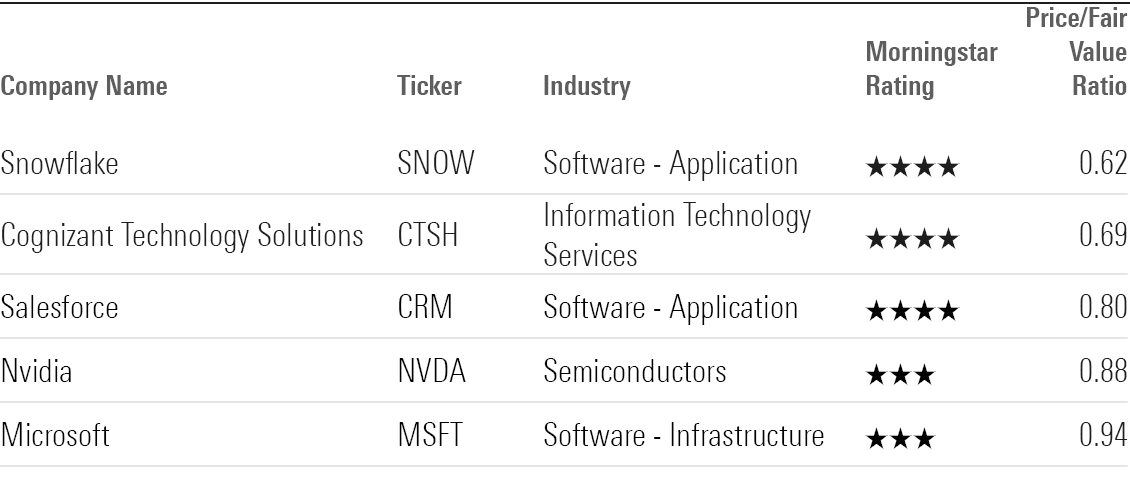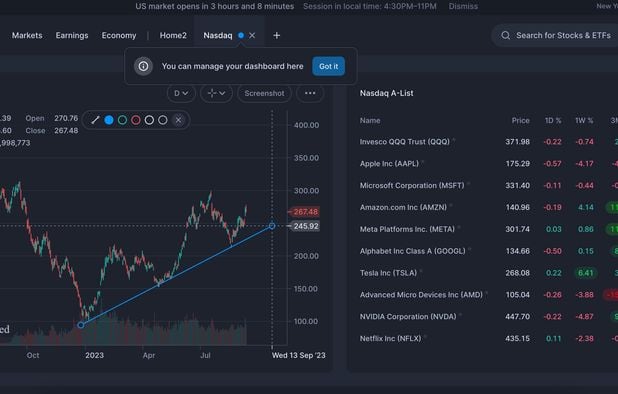In order for AI-driven trading platforms and stock prediction systems to deliver accurate and reliable insights it is vital to evaluate the quality of their data sources. A poor quality of data could cause inaccurate predictions, financial losses and distrust on the platform. These are the top 10 tips for assessing the quality of data as well as sources:
1. Verify the data sources
Find out the source of the data. Verify that the platform uses trusted and reliable sources of data, such as Bloomberg, Reuters or Morningstar.
Transparency - The platform must be open about the sources of its data and should regularly update them.
Do not rely on one platform: trustworthy platforms often combine data from several sources to minimize the chance of bias.
2. Assess Data Freshness
Real-time vs. delayed data: Determine if the platform is providing real-time data or delayed information. Real-time data is crucial for active trading. However, data that is delayed could be enough to be used for long-term analysis.
Update frequency: Check the frequency at the time that data is being updated.
Historical data consistency: Check that historical data is clear of any gaps and anomalies.
3. Evaluate Data Completeness
Find out if there is missing or incorrect information.
Coverage: Ensure that the platform has a wide variety of markets, stocks indexes, and other equities that are relevant to your trading strategies.
Corporate actions: Check if your platform allows dividends and stock splits along with mergers and other corporate actions.
4. Test Data Accuracy
Cross-verify your data: Check the data of your platform against other trusted sources.
Find out if there are any errors by looking at the outliers or financial metrics that are incorrect.
Backtesting - Use data from the past for backtesting trading strategies to determine if the results match expectations.
5. Granularity of data may be assessed
The platform should provide granular data, such as intraday price volume, bid-ask, and depth of order books.
Financial metrics: Check whether your platform provides comprehensive financial reports (income statement and balance sheet) and key ratios such as P/E/P/B/ROE. ).
6. Check Data Cleaning and Processing
Normalization of data: Ensure that the platform normalizes the data (e.g. and adjusting for dividends, splits) to ensure consistency.
Outlier handling: Check the way in which the platform handles anomalies or outliers within the data.
Incorrect data: Determine if the platform uses solid methods to fill in missing data points.
7. Evaluation of Data Consistency
All data should be aligned with the same timezone. This will avoid discrepancies.
Format consistency: Determine if the data is formatted in a consistent format (e.g., currency, units).
Cross-market compatibility: Ensure that data from different exchanges or markets are harmonized.
8. Evaluate the Relevance of Data
Relevance of your trading strategy. Ensure that the data aligns to your trading style.
Feature selection: Check if the platform includes pertinent features (e.g., sentiment analysis, macroeconomic indicators or news data) which can improve predictions.
9. Examine Data Security and Integrity
Data encryption: Ensure that the platform is using encryption to secure data as it is stored and transmitted.
Tamper-proofing: Make sure that the data is not manipulated or altered by the platform.
Conformity: Ensure that the platform you are using is compliant with any data protection laws (e.g. GDPR or CCPA).
10. Check out the Platform's AI Model Transparency
Explainability: Ensure that the platform gives you insights into the AI model's use of data in making predictions.
Bias detection: Find out whether the platform is actively monitoring and mitigates biases in the model or data.
Performance metrics. Examine the performance metrics, such as precision, accuracy, and recall to assess the reliability of the platform.
Bonus Tips
User reviews: Read the reviews of other users to gain a sense about the accuracy and reliability of data.
Trial period: You can test the data quality and capabilities of a platform with a demo or free trial before deciding to purchase.
Customer support: Ensure that the platform provides a robust support for customers to resolve issues related to data.
Following these tips will enable you to assess the quality, sources, and accuracy of stock prediction systems based on AI. See the recommended AI stock recommendations for blog info including investment ai, market ai, ai trade, ai investment app, ai for stock trading, AI stock trading app, ai investment app, AI stock trading, incite, ai for trading and more.

Top 10 Tips For Assessing The Risk Management Aspect Of Ai Stock Predicting/Analyzing Platforms
Risk management plays a vital part in any AI-based stock trading platform. It protects your capital by limiting losses that could occur and assists you in maximizing profits. A platform with robust risk management tools can help you navigate volatile markets, and make educated choices. Here are 10 top ways to evaluate the risk management capabilities of these platforms. capabilities:
1. Study Stop-Loss Features and Take Profit Features
Configurable settings: Ensure that you have the ability to set the maximum take-profit and stop-loss levels for a specific trade.
Find out if the platform allows for trailing stops. They automatically adjust themselves as market moves in your favor.
Guaranteed stops: Check whether the platform provides guarantee stop-loss orders. These ensure your position is closed at the price you specified regardless of market volatility.
2. Assessment Position Sizing Tools
Fixed amount: Make sure that the platform you're using permits you to set positions according to a fixed amount.
Percentage portfolio: Determine if the risk can be managed proportionally by setting your positions as a per centage of your overall portfolio.
Risk-reward Ratio: Verify that the platform allows for setting risk-reward levels for each individual.
3. Look for Diversification support
Multi-asset trading. Check that your platform can handle multiple asset classes such as ETFs and Forex, Options, and stocks.
Sector allocation: Check if the platform provides tools for monitoring and managing exposure to sectors.
Diversification of geographic areas. Check if the platform is able to trade internationally that spread geographical risks.
4. Examine the impact of leverage and margins
Margin requirements - Check that the platform explains the requirements for margins clearly.
Limits on leverage: See whether the platform allows you to set leverage limits to limit the risk exposure.
Margin call: Ensure that the platform has timely notifications for margin calls. This can help to prevent account closure.
5. Evaluation of Risk Analytics and Reporting
Risk metrics: Make sure the platform has important risk indicators to your portfolio (e.g. Value at Risk (VaR), sharpe ratio, and drawdown).
Assessment of scenarios: Determine whether you are able to simulate different market scenarios on the platform in order to determine possible risks.
Performance reports - Verify that the platform includes detailed performance reporting, including risk adjusted returns.
6. Check for Real-Time Risk Monitoring
Monitoring your portfolio. Make sure your platform can monitor the risk in real-time of your portfolio.
Alerts & notifications: Verify the platform's ability to provide real-time alerts for events that may be risky (e.g. breached margins and stop losses triggers).
Risk dashboards: Make sure your platform offers customizable risk dashboards to give you an entire picture of your personal profile.
7. How can you assess Stress Testing & Backtesting
Test your strategies for stress: Ensure that that the platform you select allows the testing of your strategies and portfolio under the most extreme conditions of the market.
Backtesting - Check to see whether your platform permits you to backtest strategies with historical information. This is a great way to measure risk and assess the effectiveness of your strategy.
Monte Carlo simulators: Verify that the software is using Monte Carlo to simulate a variety of possible outcomes in order for you to assess risks.
8. Risk Management Regulations - Assess the Compliance
Ensure that the platform meets the regulatory compliance requirements (e.g. MiFID II regulations in Europe, Reg T regulations in the U.S.).
Best execution : Check to find out if your platform uses best execution procedures. This ensures that trades are executed at the most efficient price, minimizing the chance of the chance of slippage.
Transparency: Check to see whether the platform is able to disclose the risks in a clear and transparent manner.
9. Check for User-Controlled Parameters
Customized risk rules: Make sure whether your platform lets you define custom risk management guidelines (e.g. the maximum daily loss, or maximum size of the position).
Automated risk controls: Verify that the platform is able to automatically enforce risk management rules according to your pre-defined parameters.
Manual overrides - Examine whether your platform allows you to manually override automated risk controls.
10. Review User Feedback and Case Studies
User reviews: Research user feedback to gauge the platform's efficiency in assessing risk.
Case studies: Look for examples or testimonials that demonstrate the risk management capabilities of the platform.
Community forums: See if the platform has an active user community where traders discuss risk management tips and strategies.
Bonus Tips
Trial period: Take advantage of a free trial or demo to try out the features of the platform for risk management in real-world situations.
Support for customers - Ensure that the platform offers a robust support for issues and questions related to risk.
Educational resources: Determine whether there are any educational resources available on the best practices for risk management.
Use these guidelines to evaluate the risk-management capabilities of AI trading platforms that can predict or analyze stock prices. Choose a platform that offers an excellent level of risk management and you'll be able to reduce your losses. It is crucial to have robust risk-management tools for navigating volatile markets. Check out the top rated the original source on ai tools for trading for blog tips including ai investment tools, ai tools for trading, best AI stock prediction, best AI stock prediction, trading ai tool, best AI stock prediction, chart analysis ai, stock trading ai, ai copyright signals, AI stock trader and more.
